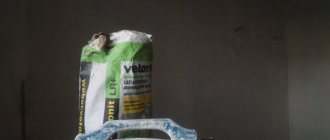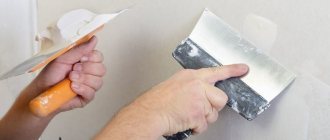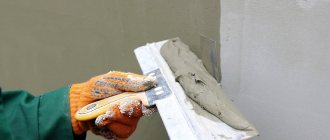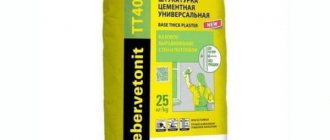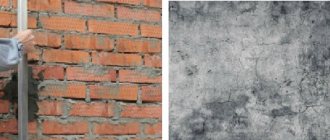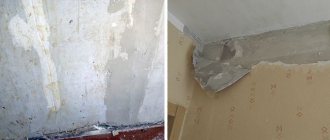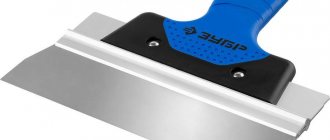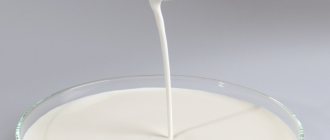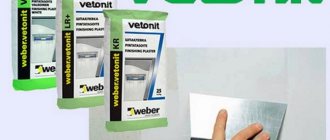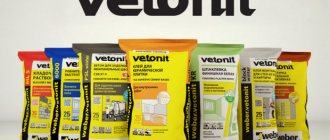Today, putty is the most popular method of finishing walls and load-bearing structures. Before the main decoration, the surface is carefully processed; one of these stages is the application of putty. In essence, this is a standard leveling of the base using special building mixtures. As experts note, Vetonit putty rightfully bears the title of the best mortar for wall finishing. Compared to other analogues, it has a lot of advantages, distinctive technical characteristics and operational properties.
Features and advantages of Vetonit putty
Building materials, the range of which is represented in a wide range, are produced by the oldest world-famous company Weber Vetonit - a leader in the field of manufacturing finishing mixtures.
The main advantages of putty:
- High adhesion to all types of substrates;
- The fine fraction in the composition has the appearance of a powder, which gives the treated surface an unusually smooth, silky structure;
- The products are environmentally friendly materials created from elements that are safe for humans and the environment;
- The mixtures have excellent water resistance, which gives them universal properties and the possibility of use in the construction of swimming ponds;
- Products marked with the “snowflake” icon on the packaging calmly withstand weather conditions such as frost, sleet, rain, and protect the facade of the building for many years;
- High-quality uniform application using different methods - no differences;
- Economical solution consumption per 1m2;
- A layer of putty can enhance thermal insulation and noise absorption of treated substrates;
- The solution prepared for use can be stored for 24 hours.
Preparation of the solution
To prepare putty with optimal structure and consistency, dilute the dry mixture with water in accordance with the proportions indicated on the package. The result should be a homogeneous mass of medium density.
Before diluting the putty mixture, you should know that water must be added to the solution in portions, and its temperature should be approximately 20 degrees.
There are some professional tips to follow:
- After the finished putty has infused a little (for 10-15 minutes) and acquires a more uniform texture, it should be thoroughly mixed again using a construction mixer.
- After mixing the solution, no more than 24 hours should pass until the putty is applied, otherwise the mixture will lose its properties and harden.
- If there is still dry mixture left in the package, it is recommended to store it in a cool (but dry) and dark place.
Types of Vetonit putties
Each Vetonit brand product has an original composition and purpose. You can select brands of mixtures:
- VH, V, TT. The products are perfect for finishing treatment in rooms of any purpose, including those with high humidity;
- L.R., K.R. The materials are intended for finishing walls and ceilings. Substrates treated with the solution are suitable for painting or wallpapering.
Vetonit VH
The product is excellent for working in high humidity conditions. Putty performs two functions - preparing the surface for decorative treatment, eliminating water droplets on ceilings and structures.
Dry mixtures are presented in white and gray shades. White color is in demand for subsequent surface painting. The gray tone is applied as a final layer before laying various tiles and pasting good quality wallpaper.
Putty is used on substrates made of various materials. These can be concrete, stone surfaces, as well as bases made of expanded clay and aerated concrete blocks.
KR and TT products
If the mixture is marked with the letters KR, then it is a finishing putty. Before applying it, a VH solution is first used. The Vetonit TT brand is universal in purpose, therefore it is used both as a starting and final material. The solution is excellent for external facade finishing work.
Vetonit LR and LR+
The materials have a viscous and thick consistency and are intended for finishing dry spaces inside the house. After applying this putty, you can cover the walls with wallpaper, or decorate the room in other ways, and cover the ceilings with water-based paint.
- Vetonite grade LR is not suitable for leveling large differences on volumetric planes or large structures. The white mixture is most suitable for processing drywall and particle boards.
- Vetonit LR+ is a polymer putty in the line of finishing building materials. It is excellent for finishing surfaces in dry rooms. The main advantages of the material are economical consumption, ease of use, quick drying, and attractive price.
The putty is applied to leveled bases, chipboard or plasterboard. Vetonit LR plus is used as an adhesive material when installing gypsum boards.
Distinctive features of the products
Applying putty is a very labor-intensive process, but using high-quality products makes it easier to putty walls and also helps the coating dry faster (regardless of the number of layers).
Vetonit Weber is a famous collection consisting of individual modifications of the putty. The most popular is Vetonit lr putty. Due to its unique composition, it is used for finishing plastered, concrete walls and ceilings, as well as plasterboard partitions.
In most cases, Weber Vetonit putties are used for external decoration of walls, as well as as a base for painting or wallpapering (for example, Vetonit putty kr). There is also façade putty designed for leveling walls outside buildings (facades).
As noted above, this series presents different types of putty, differing from each other in their composition and direct purpose. However, filler and binders (oil or other) are an integral part of all putties in this series. That is, there are two complementary components, due to which the structure of the material is unpretentious in use.
Most of the composition of the putty is taken up by filler (limestone), while polymer glue acts as a binding element.
Material strength
The mechanical characteristics of the branded line plasters differ slightly. But a cement-based mixture will still be more durable than gypsum putty.
After complete drying and hardening, approximately 30 days after applying the mortar layer, the surface strength will become 6-8 MPa.
Vetonit is an impeccable material for external and internal finishing works, as evidenced by the following characteristics:
- Drying time: 48 hours at 10°C, 24 hours at 20°C;
- Full surface load after 30 days, adhesion to concrete - over 0.5 MPa;
- Ambient temperature during plastering – 10-30°C;
- Storing the working solution for 24 hours;
- Application method: spraying or special spatula;
- Final processing after the base has dried - with fine-grained sanding paper;
- No dust after grinding;
- Shelf life - one and a half years.
Features of the material
Treating surfaces with putty is a rather labor-intensive task, but the use of high-quality products makes it much easier . In addition, good putties dry faster.
Weber Vetonit is a well-known line that includes putties of various modifications. The most popular mixture is Vetonit lr. Due to its unique properties , it is used for cladding plasterboard and concrete surfaces.
Vetonit products are often used in the design of wall structures and as a base for wallpaper or paint. There is also a facade modification that allows you to level the external surfaces of facades.
Regardless of the type, all Vetonit putties include binders and filler. That is, the composition certainly contains a couple of components that determine the unique structure of the material. The binder is a polymer-type adhesive, and the filler (limestone) fills the majority of the composition.
Composition and application
The composition of the plaster differs depending on the brand. Vetonit EP is a non-waterproof mixture based on lime and cement. Used for leveling large areas in one go.
It is not recommended to cover structures made of lime or cement-lime compounds.
- The most popular brand is Vetonit TT, its base is cement.
- Dry mixture Vetonit L is a putty on a polymer binder material.
- Vetonit T is based on adhesive organic substances.
- The layer of applied solution is 2-10 mm, maximum 30 mm, depending on the brand of material.
In a dry state, the mixtures are frost-resistant and can withstand 75-100 periods of freezing. The products are in demand in regions with harsh climates.
Methods for applying putty
Leveling walls with putty is done in two ways:
- mechanical spraying (using special equipment);
- applying the putty mixture manually (using spatulas of different sizes).
The latter option is more often applicable for putty polymer materials. It all depends only on the personal preferences and tasks of the person performing the construction work. The putty layer should not exceed 5 mm, otherwise the coating will dry out for a long time and unevenly.
When applying several layers of putty, each subsequent layer is applied only after the previous one has completely hardened.
On video: tips on puttying walls from experts.
Scope of application of Vetonit putty
The use of Vetonit putty ensures an excellent appearance of the finished structures. After the solution has dried, the walls can be decorated with ceramic tiles, mosaics, and plastic.
- If there are large differences, drywall is laid, and the seams and base are sealed with putty to obtain perfectly smooth surfaces on which the appearance of defects is excluded.
- Upon completion of work, an unpleasant odor may appear in the rooms, which disappears after the mixture dries.
Vetonit TT plaster mortars are used on a base made of brick or blocks of aerated concrete or expanded clay. The mixture is not afraid of frost, resistant to mold and other fungi.
Material consumption
The main criterion for choosing any putty for home use is its consumption. If we talk about Weber brand products, they can have different degrees of viscosity.
Before purchasing a putty mixture, you need to calculate the volume of material that will be required for the job. To simplify the task, this can be considered using the KR mixture as an example. When processing wall surfaces, about 1.2 kilograms of finished putty are consumed per square meter. In this case, six to seven liters of water is enough.
Price range
Prices for Vetonit dry mixes are quite high and may vary depending on the brand of material. The cost in construction hypermarkets varies between 500-600 rubles per 25 kg.
The goods are packaged in bags of 5 or 25 kg. The product can be stored in its original packaging for 1 year.
How much material is needed for finishing?
The main criterion when choosing a product for puttying surfaces in domestic conditions is product consumption. As for Weber putty, all models in this series have different viscosities. Thus, the version of Weber Vetonit lr putty, as well as individual modifications of Vetonit kr putty, have different consumption.
Before purchasing a putty mixture, you need to calculate the required amount of material. To make it clearer, let’s look at the consumption of Vetonit kr putty as an example. When finishing walls, about 1.2 kg of ready-made mortar is consumed per 1 m2 of surface, while seven liters of water are enough to dilute the mixture (this figure may vary depending on the structure of the material).
Review of putties and their application in practice (2 videos)
Various products (20 photos)
Some tips
Important! The remainder of the solution after finishing work should not be poured into the bathroom or sink.
If you use Vetonit on an adhesive basis, then you can attach the wallpaper when the solution dries well.
Tips for making a solution
In order to achieve optimal consistency and structure, dry putty must be diluted with water, adhering to the proportions noted in the instructions. The result should be a mass of homogeneous composition of medium viscosity.
Before mixing the components, remember that water must be added to the solution in small portions. Its temperature should be approximately 20 degrees.
Experts give some advice on this matter:
- Ten to fifteen minutes after preparing the mixture, it needs to be mixed with a construction mixer.
- Several hours (no more than 24) should pass before the composition is used after mixing. If you neglect this rule, the mixture will harden and lose its performance properties.
- The dry mixture should be stored in a dark, dry and cool place.
Photo of Vetonit putty
LKMFLOT
Code: 102020578
Category:
Putties and Plasters
Brand:
Weber-vetonit
Packing:
20
Packing:
0
Finishing facade putty Weber Vetonit Fasade (Weber Vetonit Facade)
DESCRIPTION: Cement facade putty. For final leveling of surfaces with a thickness of 1 to 5 mm. Color gray or white.
PROPERTIES: - layer thickness up to 5 mm - for interior and exterior use - high adhesion - water and frost resistant
PURPOSE: — final leveling of the surface before painting — cosmetic repairs of concrete and plastered surfaces — application to plastered surfaces
PREPARATION OF THE BASE: The base must be dry, sound and not subject to shrinkage or deformation. The base must be cleaned of dust, dirt, old paint, mortar and degreased. At ambient temperatures above 25°C, it is recommended to moisten the base before applying putty. The temperature of the base and the environment must not be lower than + 5°C. Porous substrates must be pre-treated with weber.prim multi or weber.prim A10 primer (previously diluted 1:4 with clean water).
PREPARATION OF THE MIXTURE: Pour 5.8-6.8 liters of water into a container and add 20 kg of putty (bag). The mixture must be mixed in clean water at a temperature of approximately 20°C. The amount of water depends on environmental conditions and surface porosity. The mixture must be mixed mechanically using a drill mixer at medium speed (400 - 600 rpm) to achieve a homogeneous mixture without lumps. Leave the mixture for 5 minutes to “ripen”, then stir again. After this, apply the putty to the wall using a spatula or trowel, the permissible thickness of one layer is up to 4 mm; greater thickness can be obtained by applying the putty in several layers with intermediate drying of each layer for at least 8 hours. After the putty begins to dry (after 2-3 hours), carefully sand it using an abrasive material. At 20°C and normal humidity, the prepared putty remains viable for at least 2 hours. As the temperature decreases, this time increases, and as the temperature rises, it shortens.
NOTE: While drying, the putty must be protected from high temperatures, direct sunlight and wind. When applying putty for the first time or when environmental conditions change, it is advisable to check and establish the optimal proportion of water and mixture in a small area, but then stick to it very precisely. If there are expansion joints on the base, then when applying the mixture it is also necessary to make expansion joints, repeating their geometry and filling them with polyurethane sealant.
APPLICATION: To apply the putty, you need a narrow spatula measuring 80 - 100 mm and a wider one - about 250 mm wide. To putty walls with large deviations from the main plane, metal rulers are used. The putty is applied to a ruler 2-2.5 m long, evenly “stretched” along it with a small spatula and applied to the wall. This method is effective where there is a need to apply a layer of putty several centimeters thick. Relatively smooth walls can be puttied with a regular spatula without any problems. If you apply a layer from left to right, the upper part of the spatula should be to the right relative to the bottom, if from right to left - to the left. When putting putty from bottom to top or top to bottom, the nature of the movements is similar. The inevitably resulting sagging is smoothed out with a spatula during the subsequent application of putty. The optimal angle of inclination of the spatula to the wall surface is 45-60°C. Changing it leads to a change in the thickness of the applied layer. The corners formed by the walls and ceiling are puttied with a specially designed corner spatula. After applying the putty, it should be allowed to dry, then sanded with abrasive paper or mesh if necessary.
TECHNICAL CHARACTERISTICS: Binder: cement Color grey, white Maximum fraction, mm0.5 Application temperature from +5C to +25C Mixture consumption, kg/m2/mm1.4 Water consumption, l/kg0.29-0.31 Life time, h2 Drying time , h3 Compressive strength, 28 days, MPa10 Adhesion, MPa1.0 Frost resistance, cycles, not less than 75
CLEANING TOOLS: Hands, tools and containers must be cleaned with warm water immediately after finishing work.
PRECAUTIONARY MEASURES: When working, you must use rubber gloves, avoid contact with skin and eyes, in case of contact with eyes, rinse with plenty of water, keep away from children.
PACKING: Three-layer paper bag with a middle layer of polyethylene - 20 kg.
STORAGE: 12 months from the date of manufacture if stored in original packaging on a pallet in a dry room (relative humidity not higher than 60%)
Vetonit putty: types
- Vetonit B, based on cement, is a finishing waterproof composition used for leveling walls and ceilings in facilities with high humidity;
- Vetonit VX is a cement-based finishing waterproof composition created for leveling ceilings, walls in wet rooms, facades;
- finishing putty Vetonit KR - created for leveling surfaces in dry rooms;
- composition Vetonit T - used for treating ceilings and walls in dry rooms;
- polymer putty Vetonit LR Fine - created for rooms with a normal degree of humidity;
- putty based on limestone and white cement Vetonit VH - used for finishing coating of ceilings, walls made of concrete, brick, expanded clay concrete, lightweight concrete, plastered surfaces. In addition, it is used for finishing facades and inside objects;
- Vetonit LR+ polymer putty is intended for treating surfaces located indoors with normal humidity.
Also today there are special Vetonit mixtures used for leveling the floor - Vetonit 1000, 1500, 3000, 4000, 5000, 6000.
Characteristics of Vetonit
- Vetonit putty consumption is 1.2 kg/m2/mm.
- During the process of leveling walls with Vetonit, the temperature of the mass, the treated surface and the room should be from +10ºС.
- It is recommended to use this building material within 24 hours from the moment it is mixed with water.
- The drying time of the Vetonit composition depends on the air temperature, ventilation in the room, and layer thickness.
- For 25 kg of dry mixture, about 10.5 liters of water are needed. Drying period - 1-2 days.
